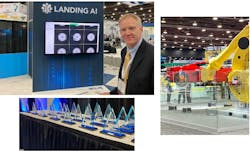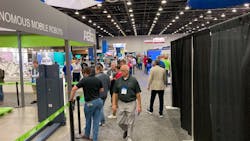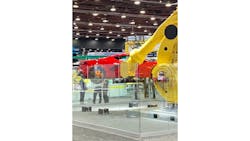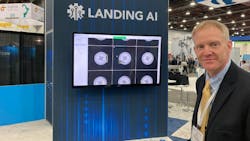Automate 2022 Reveals Automation Trends
Automate 2022 returned to being an in-person event after briefly pivoting to a virtual event in 2021. This was my second trade show since joining Vision Systems Design, and it appears attendance at trade shows is on an upward trend. There were hand sanitizing stations located around the show floor but no mask mandates, and the crowds made it clear that members of the automation market were ready to see the latest innovations and network in a trade show environment.
Innovators Awards
Vision Systems Design kicked off the show by announcing the 2022 Vision Systems Design Innovators Awards Honorees. Those on hand were able to accept their award and display it at their booth. Now in it’s eighth year, this program celebrates innovative technologies, products, and systems found in machine vision and imaging.
This year’s Platinum Honoree was the CV3 AI domain controller family from Ambarella. It enables centralized, single-chip processing for multisensor perception—including high-resolution vision, radar, ultrasonic, and lidar—as well as deep fusion for multiple sensor modalities and AV path planning. The result is robust ADAS and L2+ to Level 4 autonomous driving systems with greater levels of environmental perception. Click here to view all of this year’s honorees.
Trends
The entire globe is still working to emerge from the Pandemic. The chip shortage, publicized in the beginning because of new vehicle shortages, has impacted most if not all aspects of automation. Some suppliers predicted the chip interruption and planned accordingly, purchasing a large enough supply to keep making their products. The component shortages went beyond chips though, and as vision system component makers worked to fill orders, prices fluctuated and continue to fluctuate—when parts have been available. Those who planned ahead have now exhausted their supply of components for their products and are now entering the fray, increasing demand for parts that are hard to come by due to supply chain challenges. No one can predict exactly how long this will continue, but at least for the foreseeable future, expect longer turnaround times on parts orders for your vision/imaging systems.
Another offshoot of the Pandemic has been a labor shortage. Companies have come to rely more on automation as they experience a lack of labor and must reallocate existing employees. Vision systems have often been used to help eliminate human error during inspection. However, they are also critical parts of much of the automation equipment factories employ to assist with assembly tasks, among other things. As the need for automation increases, so will the need for vision/imaging systems.
Another indicator for automation’s growth has been the robotics market, particularly in North America. And, if the Automate show floor was any indication, the demand for robots today remains high. Of particular interest to me was how vision systems are used for robotics and how many companies are building turnkey solutions that include everything a customer would need to plug a robotic arm in and get straight to work. I’ve seen an increase in news about turnkey solutions come across my desk of late. As usual, I am sure whether to use a turnkey product depends on the application, but I still found the number of solutions, particularly on the robotic side, of interest. Just about everyone we spoke with at the show indicated a huge growth area for them has been in logistics and warehousing, and robotics plays a huge role there. If you haven’t been approached yet to develop an imaging system to be used in a logistics application, it wouldn’t surprise me if you are soon—whether it includes robots or not.
It's hard to go anywhere these days without hearing AI mentioned somehow. We talk about it all the time in machine vision. Since last year, I have heard many suppliers describe how they are working to make deep learning and AI easier to implement on the front end. At one point during Automate, I visited the Landing AI booth to speak with David Dechow, Landing AI’s VP Outreach and Vision Technology, and Andrew Ng, Landing AI’s CEO. We were discussing this trend about easing implementation, when Ng suddenly asked me, “Chris, have you ever built an AI model?” My reply was no, and the next thing I knew I was in front of one of the demo stations in the booth building my first AI model. I can attest that, as someone without any experience building AI models, the process is quite easy. Obviously, there’s a little learning to do to use the software, but I picked up what I needed to do quickly and successfully built a model for screwhead inspection, identifying which parts were good and which were bad. Dechow reminded me that there is a lot of work on the back end to make the front end so simple. Ng’s message? “If you have never built a deep learning model, just try it,” he said. I mean, if I can do it…..
There were more than 500 exhibitors at Automate. Attendee traffic was consistent throughout the day, and exhibitors indicated the leads they received were concrete leads—no tire kickers this year!




